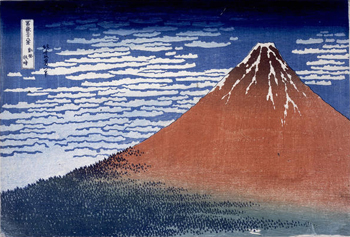
South Wind, Clear Skyalso known as Gaifu kaisei, or Red Fuji

|
Under just the right conditions in late summer and early fall, it is said that the rays of the rising sun can dye the slopes of Mount Fuji red for a fleeting moment. The beauty of this spectacle is poetically captured here by Hokusai.
Gaifu kaisei is one of thirty-six paintings in Hokusai's series Fugaku sanju-rokkei (Thirty-Six Views of Mount Fuji). Of the entire series, Gaifu contains not only the most abstracted construction, but, paradoxically, the most meteorologically specific subject matter. The mountain, notably attenuated towards the top, and the sky are both made up of three color tones. The cone of the mountain against the blanket of sky, their color shades almost inverses of the other, stand in opposition to one another, dominating the picture with their massive presence.
This larger-than-life quality accentuates the ethereal quality of the phenomenon that has been captured in ink. Indeed, Fuji takes on a unique power in this image. The clouds inexplicably form a halo about the top of Mount Fuji, as if they themselves were deliberately parting for the peak. The slopes above the tree-line are bathed in an almost impossibly bright, brick-red light. The mountain stands against the sky with a unique starkness and contrast. It is clear that this is a rare and special sight.
Different impressions of this work evoke very different moods, perhaps because of its power combined with its simplicity. An early impression from the Museum of Art, Atami, has a pale blue sky contrasted with pinkish slopes. In another impression, Fuji has almost no coloration at all. The differences are simple, but the results are profound. It is only this famous impression that carries its unique, awesome quality.












